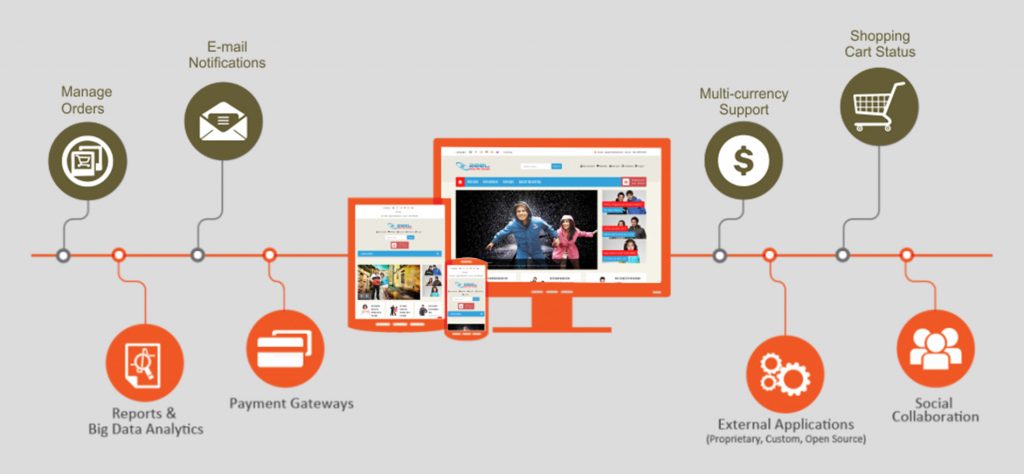Ok, so you are looking to venture into e-commerce industry… And now you want the best e-commerce website design ideas to get started.
Well, we certainly hope you make the ends meet.
That’s to say because the e-commerce market is a hyper-competitive industry with cut-throat competition. Lest not we forget that it is also one of the biggest markets that’s still isn’t reached its halfway point and will continue to expand in foreseeable future. Talking about the market size, the e-commerce market is expected to exceed $4 trillion by the next year; that’s a serious market to compete, right?
However, you can’t just tap into this massive market without a well thought-off and strategically created website and for that, you need an exception e-commerce UI design, a robust e-commerce website development process and more than anything else some inspiring e-commerce website design ideas.
Now, according to studies, beauty and aesthetics don’t depend on any one factor, rather there are various scientific factors that influence the people’s response towards the visual content. Well, that’s considerably reasonable if you understand the fact that nearly 20% of your brain is specifically devoted to vision.
So, the one takeaway with all these stats is the fact that you need a brilliantly designed and well-thought-off e-commerce website to be able to capture sales. And whether you are planning to go with certain e-commerce design patterns from Shopify theme or looking to build your own customized website from scratch, you need to study behavior patterns, preferences, and perceptions of your target audience to be able to relate with the market and connect with the audience.
What is meant by an e-commerce website?

Now, before we take a dive into the making of interactive and engaging e-commerce UI designs, it would be better to get started with some basic information regarding e-commerce website.
Now, to start off, an e-commerce website is much different from traditional dynamic websites that we visit regularly. The biggest difference being the fact that an e-commerce website comes with an online payment gateway that let users make online transactions safely and securely. Some of the more popular e-commerce websites include Shopify, eBay, Amazon, Ali Baba, etc.
While it’s certainly much more painstaking to design and develop an e-commerce website as compared to traditional websites, there are certain perks of bearing those pains as well including:
- You have a 24/7 platform to sell products/services
- It’s convenient for customers to buy online
- It’s a lot quicker and efficient than traditional sales methods
- You get free from geographic boundaries (target global audience)
- Significantly lower starting cost as compared to brick and mortar stores
- Quick to set-up (compared to traditional brick and mortar store)
- Endless themes and patterns to choose from
Now, contrary to the common perception that the e-commerce market is more tilted in favor of B2C business models, today more and more B2B businesses are turning to e-commerce stores for online businesses. And to top it off with a cherry, the B2B market is expected to surpass the B2C market by 2020.
So, there you have it. A very lucrative market with endless potential and loads of benefits; perfect for businessmen who like to take risks and rise over the challenges.
What are the best e-commerce website design ideas?
Ok, now that we have a thorough understanding of the working and benefits of the e-commerce market, let’s take a detailed look into the e-commerce website UI design ideas:
- Design considerations

Obviously, we are going to start off with the design considerations that include creating a positive and dynamic brand perception that go well with the target audience.
Talking about design ideas, the foremost consideration in this aspect include researching your target market and relating with the audience. Remember, your e-commerce website design will become the face of your business and it will influence the way the audience will see and relate with your business. Thereby, if you are looking to engage visitors to the website and get more sales and loyalty from customers, you need to give them a pleasurable experience (feed them what they like).
Just as a word of caution, don’t take “Eye Catching” website design as a synonym to flashy or extravagant design.
Today, it’s all about following a minimalist design. Keep your e-commerce website design to a minimum and only add elements that actually adds value to your website and gives a sense of trust, reliability, and professionalism to customers. There are literally endless inspirational themes and ideas available over the internet and you just got to find the right theme that relates with your products/services and desires of the target audience.
Below are some important Don’s and Don’ts for an interactive and engaging e-commerce website design:
Do’s
- Implement minimalism – Keep your website design as clean as possible. Avoid cluttering elements one over another and follow a sensible visual hierarchy for customers’ ease of navigation
- Thanks to Google Fonts, it’s easier than ever to lend personality with custom fonts. As a precaution, be sure that the fonts you use are readable
- Try telling your story by creating miniature design cues
Don’ts
- Cluttering – Don’t try to fill your website design with everything you can. That’s bad for your business health
- Don’t go with flashy extravagant themes or patterns
- Don’t use stretch contents – make your content readable by using different images and infographics
- Don’t use too many distractive elements on the website
- Responsive design

Ok, if you haven’t been living in Siberia or somewhere in the Alaskan woods, you may already know the world has shifted to mobile devices already.
And if you don’t know that be it known that the number of mobile users has already surpassed the traditional desktop users (that’s an old new to say), which also means that there are a greater number of users who might be looking for your products/services using mobile devices than desktop devices.
Now, according to Google (the largest search engine in the world and your best bet towards business success), responsive website design or a mobile website refers to the design that adjusts to the varying screen sizes and stays equally interactive and valid. That is to say, you need to prepare a responsive website that is able to target all device users (mobile, tablets, laptops, etc.).
Here are some of the stats which might help you the severity and importance of going with a responsive e-commerce website design:
- Last year, Google has already rolled out its “Mobile First Indexing”, which is aimed to prefer websites that are responsive. While at present, Google hasn’t put any penalty for non-responsive websites, that’s not entirely off the cards as well
- Over 50% of Australians owns a smartphone and that’s on the rise
- 50% of people tend to prefer dealing with e-commerce stores with a responsive website
So, while there are various other important aspects of e-commerce design patterns, make sure you don’t overlook the responsiveness of the website.
- Products
– High-Quality Images

We are already at the verge of 5G internet and when that happens, the internet will take a radical shift. Nonetheless, even with 4G technologies, it’s all about impressing users with professional and high-quality images of the products, as a mean to build trust.
Remember, when shopping online customers can’t physically see or touch the product; thereby their best bet to judge the quality of the product is visual. Today, more and more leading e-commerce stores are breaking the market with life-size images of products where customers can literally get a feel for the product. Thereby, when looking for e-commerce website design ideas, make sure high-quality product images are right at the top of your consideration.
– Navigation
Ok, I can’t put enough emphasis on the importance and usefulness of integrating a robust and highly functional navigation system to your website. Website navigation system acts just like Google Maps, helping customers to search across hundreds and thousands of products easily. Besides, you need to remember that customers’ today are impatient and don’t like to interact with inefficient websites. So, if they aren’t able to find what they are looking for easily, they will switch to another website.
– Put on the filters
Filters not just help users to search desired products, rather also help them make decisions. This is especially true for filters like “Best Seller”, “Most liked” etc. that help build customers’ choices. Moreover, the rating and review system for products is also a great functionality to help build users trust over the quality of products. Thereby, when choosing an e-commerce website design, make sure it comes with various value-added functionalities
– Out of Stock Products
Ok, while this might not go around the mind as the most important consideration for your e-commerce website, when it’s come to reputation and trust building it’s one heck of important functionality. As a start-up e-commerce website owner, the last thing you would want is to make fake promises that will just annihilate your business reputation and loyalty. Thereby, make sure to have automated functionality for listing out of stock product at the time of the website development process to save you the shame.
– Relevant Information
One way to building customers’ trust and increase sales is to offer customers as much relevant information about the product as possible. Again, as the concept of e-commerce store revolves around convenience, customers’ aren’t going to call you to know details of the products, rather they will prefer ordering from stores that have already listed all they wanted to know.
Below is some information that you should always list with your products:
- Price
- Colors
- Measurements
- Materials used
- Technical information
- Included extras
- Returns policy
- Be Reachable

Another important e-commerce website consideration is to ensure reachability and access to customers. Make sure to list down all possible channels of communication including physical address, phone number, email as well as online form number. Listing multiple contact channels will give reassurance to customers that your business can be relied upon. Contact details that needed to be listed on the website may include:
- Phone Number
- Social media accounts
- Postal Address
- Shopping cart

There are few key concerns in this respect which needed to be taken care of for a smooth and reliable e-commerce website design experience.
Although online payment gateways have become quite reliable and secure, there are still people who aren’t comfortable with making online transactions. Now, to offer them a sense of confidence and reliability, your shopping cart should be as clean and clear as possible. Don’t make it overly complicated for customers to make payments, rather keep it as simple as possible by choosing the right e-commerce platforms like Shopify, Magento or others.
Another important aspect to look out in this regard is tracking the “abandoned customers”. Generally, there will be at least 25% of customers who’re going to opt out short of making payment. In industry, this is known as “Shopping cart abandonment”. Now, even though this may look like a sad situation for the business, there are some e-commerce platforms which actually offers a solution for this problem by keeping track of customers’ information and using that information to resell to potential customers.
Concluding:
There you have it, all the important considerations for e-commerce website design and development process. Just remember, the e-commerce market is one of the most highly competitive markets you would like to venture, but at the same time it’s also one of the most promising markets with higher ROIs for businesses who have done the background research and are ready to implement agile systems.
The key to success in this competitive market remains to get to the nerves of the market and understand the strengths and limitations of the market. From researching the target audience to engaging designs, building trust and reselling to lost customers; it’s all about creating a streamlined process to attract, engage and close customers for sales.
















